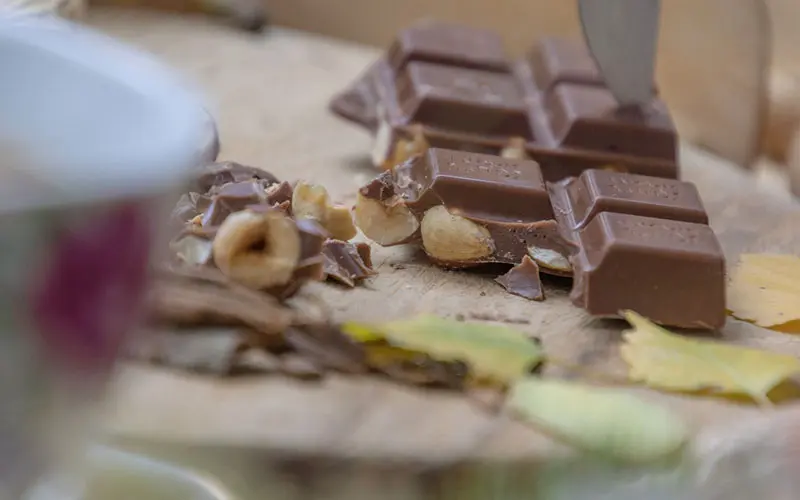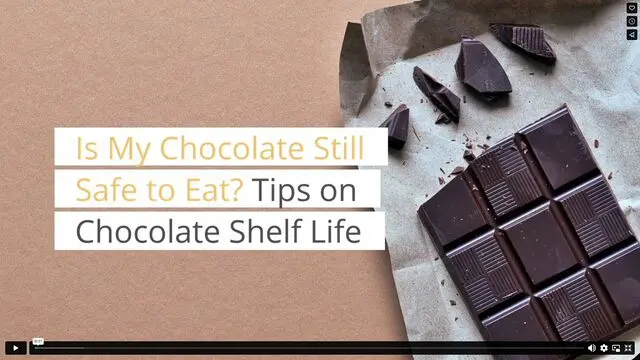It’s late. You’re munchy. You decide that some chocolate would really scratch the itch, so you set to tearing apart your pantry because there’s got to be some chocolate in there somewhere! Suddenly – what luck! – you see an aluminum wrapper winking at you from behind the Rice-A-Roni. Could it be? The last of that fancy chocolate your friend bought you for your birthday a few months ago? The very stuff you’ve been saving for a special occasion such as tonight?
You open it up, and much to your dismay, the chocolate looks white and chalky, and there are little crystals everywhere. You know that this was expensive chocolate, and it would be such a waste if you couldn’t eat it, but still, that niggling thought is poking the back of your brain – is this chocolate still safe to eat?

(rottonara / pixabay)
The answer to that depends on a lot of factors regarding chocolate shelf life, which we will address here today. (But most likely, yes, it’s still good.)
Blooming Chocolate
Probably the most common problem you’ll find with chocolate is either fat bloom or sugar bloom. It is the culprit behind that chalky, white, mottled appearance that can make chocolate look unappetizing. You’ll find it on everything from chocolate chips to bar chocolate to gourmet bonbons if you’re not careful how you store things.
What is sugar bloom?
Sugar bloom happens when your chocolate comes into contact with moisture (most commonly very humid environments). It makes your chocolate look kind of dusty and grey, and that can be very unappetizing. Unfortunately, there isn’t anything you can do to correct sugar bloom, so if you want to avoid it, you have to prevent it in the first place.
You’ll run into sugar bloom if you keep your chocolate in the freezer or refrigerator, but you don’t let it thaw slowly. Ideally, you will store your chocolates in a sealed container at room temperature, but sometimes life necessitates keeping chocolate in the fridge or freezer. If you plan on storing it in the freezer, start by putting it in the fridge for a full day before moving it to the freezer. When you’re ready to eat the chocolate, just reverse the process and slowly bring your chocolate back to room temperature. Going slow will help prevent some of the condensation that causes sugar bloom.
If you are working with chocolate, just ensure that all molds and forms are completely dry before you pour in the chocolate. Having any water on your molds will likely cause sugar bloom once the chocolate sets.
What is fat bloom?
On the other hand, fat bloom happens when the chocolate is allowed to soften or melt and then solidify again. When this occurs, some of the delicious cocoa butter separates from the cocoa solids and regroups into those little white colonies on and throughout the chocolate. This process won’t necessarily affect the taste or texture, but it is unsightly. Luckily, if you want to use the chocolate to make something chocolate, melting and retempering it will get the chocolate back to its glossy brown color. Otherwise, eating chocolate with visible fat bloom will still be tasty if you don’t mind how it looks.
Flavor Absorption
Chocolate, for all of its many admirable qualities, is something of a copycat where flavors are concerned. While that’s a great thing when you’re pairing chocolate with other foods, it’s not great when you’re storing chocolate in the pantry or fridge. If you aren’t really careful, your chocolate could end up tasting like citrus, yesterday’s leftovers, or those slightly-too-old potatoes sitting in your pantry.
To help your chocolate retain its original flavors (and avoid any unintended ones), make sure that you store your chocolate in at least one airtight container. A Ziploc bag and/or Tupperware should do the trick to keep flavors separate, but you should still choose a location that doesn’t have a lot of smelly things nearby.
Standard Shelf Life
There is a bit of a grey area regarding the shelf life for chocolate, so you do what’s best for you. On the one hand, eating chocolate by its expiration date is always a good rule of thumb. However, a lot of people feel that the expiration dates put an arbitrary timeline on chocolate’s goodness, so they recommend smelling and looking at your chocolate before eating it. Any mold or bad smells mean that you should throw that stuff away, regardless of the expiration date.
Other people feel that unopened dark chocolate is good for two years, milk chocolate for one, and white chocolate for about six months from the date of manufacture (not the “best by” date). Once you’ve opened the container, though, those timelines cut in half to one year, six months, and three months for dark, milk, and white, respectively. Gourmet chocolate and filled bonbons should be eaten by the manufacturer’s expiration date because of the added ingredients inside.
Keep in mind that the longer chocolate is exposed to air, light, heat, humidity, and surrounding flavors, the less tasty it will be, so in general, you should probably indulge sooner than later.
Chocolate is one of life’s little joys, so whether you plan to send cookies in the mail or include chocolate in this year’s corporate gifts, using and including fresh chocolate is sure to be a hit!
Video

